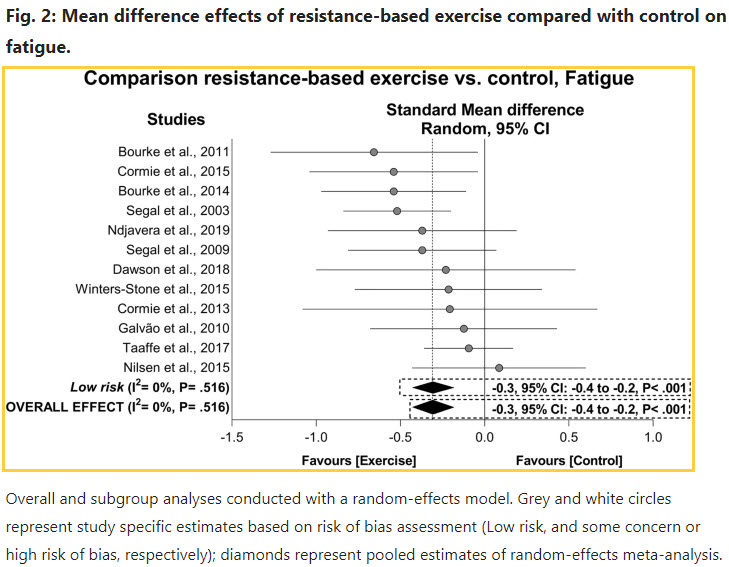What is the minimal dose for resistance exercise effectiveness in prostate cancer patients? Systematic review and meta-analysis on patient-reported outcomes
Even a relatively low dosage of resistance training results in clinically significant benefits in men with prostate cancer if intensity is moderate to high. This is in part because most are untrained to begin with. Whether such a low dosage is effective after 3-6 months is yet to be determined. However, by starting with low dosage compliance and retention might be facilitated with further progression once the exercise habits are established.
Abstract
Background
Active treatments for prostate cancer are well known to result in several adverse effects such as fatigue, depression and anxiety symptoms, impacting the overall quality of life (QoL) and wellbeing of a considerable proportion of patients. Resistance-based exercise interventions have shown positive effects to reduce or mitigate these treatment-related side effects. However, the minimal dosage required to derive these benefits is unknown. We systematically reviewed the resistance training effects in prostate cancer patients to determine the minimal dosage regarding the exercise components (mode, duration, volume and intensity) on fatigue, QoL, depression and anxiety.
Methods
Using PRISMA guidelines, MEDLINE, CINAHL, EMBASE, SPORTDiscus and Web of Science databases were searched. Eligible randomised controlled trials examined prostate cancer patients undertaking resistance-based exercise programs during or following treatment. Meta-analysis was undertaken when more than three studies were included. Associations between resistance exercise components and its effects were tested by meta-regression analysis.
Results
Eighteen trials involving 1112 men with prostate cancer were included. Resistance-based exercise programs resulted in significant effects on fatigue (effect size = −0.3, 95% CI: −0.4 to −0.2, P < 0.001) and QoL (effect size = 0.2, 95% CI: 0.0 to 0.4, P = 0.018), with significant effects in specific questionnaires and domains of these outcomes. Resistance-based exercise effects on depression (effect size = −0.3, 95% CI: −0.7 to 0.0) and anxiety symptoms (effect size = −0.3, 95% CI: −0.5 to 0.0) were positive but not significant (P = 0.071 to 0.077). Meta-regression indicated no significant association between resistance exercise components with fatigue and QoL outcomes (P = 0.186–0.689).
Conclusions
Low volume resistance exercise undertaken at a moderate-to-high intensity is sufficient to achieve significant fatigue and QoL benefits for men with prostate cancer and also mitigate depression and anxiety symptoms. A lower resistance exercise dosage than usually prescribed may help enhance adherence by reducing exercise barriers.


Leave A Comment
You must be logged in to post a comment.